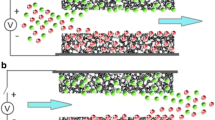Abstract
Capacitive deionization has been developed as a promising desalination alternative for removing ions from aqueous solutions. In this study, the evaluation of capacitive performance was carried out by galvanostatic charge/discharge and cyclic voltammetry experiments. The good capacitive and electrosorption behaviors suggest carbon aerogel not only treated as an electrical double layer capacitor, but also as a potential electrode in capacitive deionization processes. Also, the capacitive deionization characteristics indicate that electrosorption/regeneration can be controlled by polarization and depolarization of each electrode. It implies that sodium and chloride ions are electrostatically held to form electrical double layer on the surface of charged electrodes. The electrosorption performance at different applied voltages and solution concentrations was investigated. It is found that the removal of sodium chloride increases with increasing applied voltage and solution concentration, resulting from stronger electrostatic interactions, higher concentration gradient, and less double layer overlapping effect. Based on Langmuir isotherm, the equilibrium electrosorption capacity at 1.2 V is determined as 270.59 μmol/g. Under this condition, due to the presence of micropores associated with the double layer overlapping, the effective surface area for electrosorption of ions at 1.2 V is estimated in the range of 12.18–14.25 % of the Brunauer–Emmett–Teller surface area. The results provide a fundamental understanding of electrosorption of ions and help promoting capacitive deionization technology for water purification and desalination.







Similar content being viewed by others
References
Anderson MA, Cudero AL, Palma J (2010) Capacitive deionization as an electrochemical means of saving energy and delivering clean water. Comparison to present desalination practices: will it compete? Electrochim Acta 55:3845–3856
Farmer JC, Fix DV, Mack GV, Pekala RW, Poco JF (1996a) Capacitive deionization of NaCl and NaNO3 solutions with carbon aerogel electrodes. J Electrochem Soc 143:159–169
Farmer JC, Fix DV, Mack GV, Pekala RW, PoCo JF (1996b) Capacitive deionization of NH4ClO4 solutions with carbon aerogel electrodes. J Appl Electrochem 26:1007–1018
Farmer JC, Bahowick SM, Harrar JE, Fix DV, Martinelli RE, Vu AK, Carroll KL (1997) Electrosorption of chromium ions on carbon aerogel electrodes as a means of remediating ground water. Energy Fuels 11:337–347
Frackowiak E, Béguin F (2001) Carbon materials for the electrochemical storage of energy in capacitors. Carbon 39:937–950
Gabelich CJ, Tran TD, Suffet IH (2002) Electrosorption of inorganic salts from aqueous solution using carbon aerogels. Environ Sci Tech 36:3010–3019
Hou CH, Liang CD, Yiacoumi S, Dai S, Tsouris C (2006) Electrosorption capacitance of nanostructured carbon-based materials. J Coll Interf Sci 302:54–61
Hunter RJ (2001). Foundations of Colloid Science, 2nd edn, Oxford University Press, Oxford
Jung HH, Hwang SW, Hyun SH, Lee KO, Kim GT (2007) Capacitive deionization characteristics of nanostructured carbon aerogel electrodes synthesized via ambient drying. Desalination 216:377–385
Kim YJ, Choi JH (2010) Enhanced desalination efficiency in capacitive deionization with an ion-selective membrane. Sep Purif Tech 71:70–75
Koresh JE, Soffer A (1987) The carbon molecular-sieve membranes: general properties and the permeability of CH4 and H2 mixture. Sep Sci Tech 22:973–982
Li H, Zou L (2011) Ion-exchange membrane capacitive deionization: a new strategy for brackish water desalination. Desalination 275:62–66
Li HB, Zou LD, Pan LK, Sun Z (2010) Novel graphene-like electrodes for capacitive deionization. Environ Sci Tech 44:8692–8697
Noked M, Avraham E, Soffer A, Aurbach D (2009) The rate-determining step of electroadsorption processes into nanoporous carbon electrodes related to water desalination. J Phys Chem C 113:21319–21327
Okoye AI, Ejikeme PM, Onukwuli OD (2010) Lead removal from wastewater using fluted pumpkin seed shell activated carbon: adsorption modelling and kinetics. Int J Environ Sci Tech 7:793–800
Onundi YB, Mamun AA, Al Khatib MF, Ahmed YM (2010) Adsorption of copper, nickel and lead ions from synthetic semiconductor industrial wastewater by palm shell activated carbon. Int J Environ Sci Tech 7:751–758
Oren Y (2008) Capacitive delonization (CDI) for desalination and water treatment—past, present and future (a review). Desalination 228:10–29
Pröbstle H, Wiener M, Fricke J (2003) Carbon aerogels for electrochemical double layer capacitors. J Porous Mat 10:213–222
Seo SJ, Jeon H, Lee JK, Kim GY, Park D, Nojima H, Lee J, Moon SH (2010) Investigation on removal of hardness ions by capacitive deionization (CDI) for water softening applications. Water Res 44:2267–2275
Villar I, Suarez-De la Calle DJ, González Z, Granda M, Blanco C, Menéndez R, Santamaría R (2011) Carbon materials as electrodes for electrosorption of NaCl in aqueous solutions. Adsorpt J Int Adsorpt Soc 17:467–471
Xu P, Drewes JE, Heil D, Wang G (2008) Treatment of brackish produced water using carbon aerogel-based capacitive deionization technology. Water Res 42:2605–2617
Yang KL, Yiacoumi S, Tsouris C (2003) Electrosorption capacitance of nanostructured carbon aerogel obtained by cyclic voltammetry. J Electroanal Chem 540:159–167
Ying TY, Yang KL, Yiacoumi S, Tsouris C (2002) Electrosorption of ions from aqueous solutions by nanostructured carbon aerogel. J Coll Interf Sci 250:18–27
Zou LD, Li LX, Song HH, Morris G (2008) Using mesoporous carbon electrodes for brackish water desalination. Water Res 42:2340–2348
Acknowledgments
The authors acknowledge the supports of the National Science Council of Taiwan under Grant No. NSC- 99-2218-E-029-003.
Author information
Authors and Affiliations
Corresponding author
Rights and permissions
About this article
Cite this article
Hou, C.H., Huang, C.Y. & Hu, C.Y. Application of capacitive deionization technology to the removal of sodium chloride from aqueous solutions. Int. J. Environ. Sci. Technol. 10, 753–760 (2013). https://doi.org/10.1007/s13762-013-0232-1
Received:
Revised:
Accepted:
Published:
Issue Date:
DOI: https://doi.org/10.1007/s13762-013-0232-1




